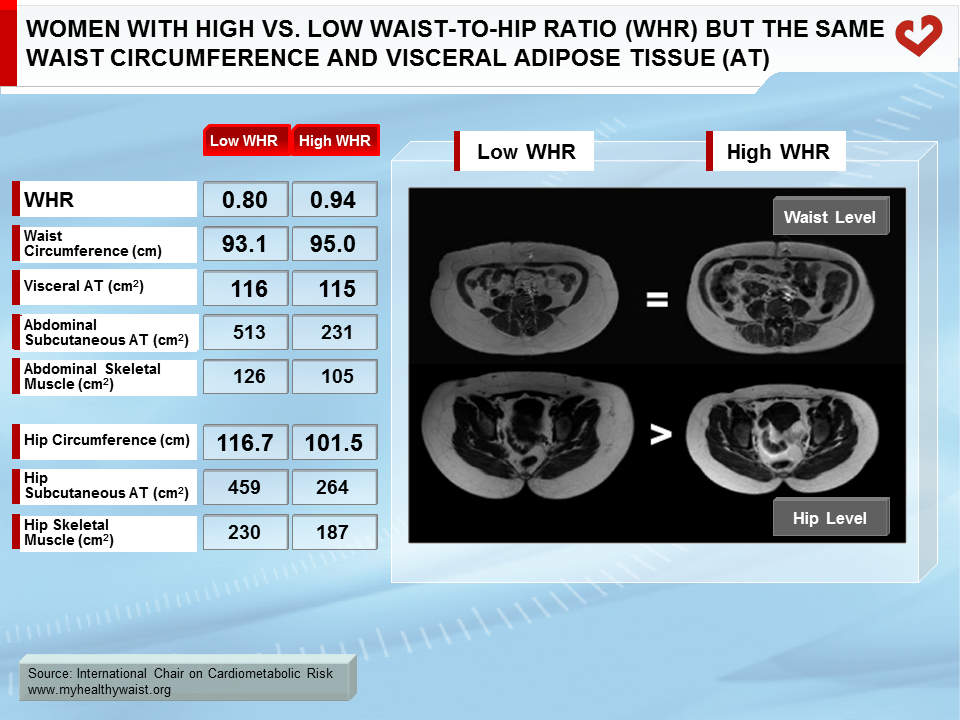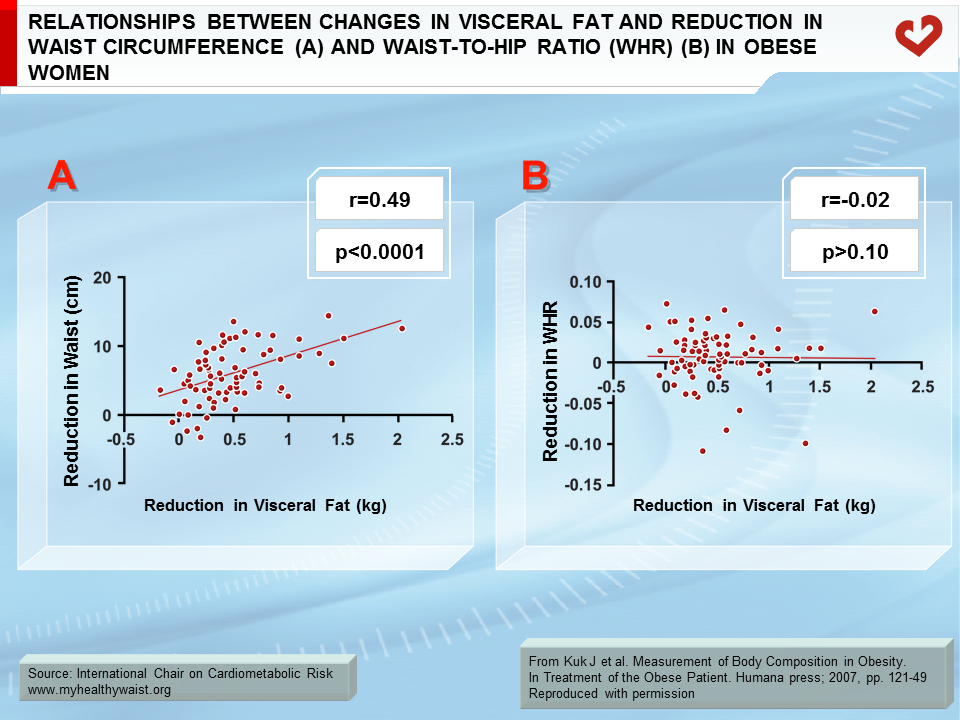Waist-to-hip Ratio (WHR)
Evaluating CMR - Clinical ToolsKey Points
- WHR is a significant predictor of morbidity and mortality risk.
- WHR is a good measure of abdominal fat distribution, but is not a measure of absolute abdominal fat mass.
- Changes in WHR with weight loss are weakly associated with changes in abdominal fat mass and health risk.
WHR, Health Risk, and Visceral Fat
Waist-to-hip ratio (WHR) is an anthropometric measure commonly used to characterize regional adiposity. WHR is a crude estimate of the relative amount of abdominal fat: the higher your waist girth compared to your hip girth, the greater your proportion of abdominal fat. As early as the 1980s, several prospective epidemiological studies reported that WHR is a significant predictor of type 2 diabetes, (1) coronary heart disease, (2) and death (3,4). A large number of studies have since replicated these initial findings (5,6), with some reporting that WHR was a stronger predictor of myocardial infarction (7) or mortality risk (8) than body mass index (BMI) or waist circumference alone. However, this observation is not seen consistently, as most studies report that waist circumference is an equivalent, if not a superior, measure of health risk (9-13) and mortality (14-16). WHR is also reported to have a similar relationship to visceral (visceral) fat as waist circumference and BMI (17-24). Consequently, as WHR provides no clear advantage in predicting health risk, it has been suggested that waist circumference may be a more clinically useful tool because it is easier to measure.
Measuring WHR
WHR is a measure of waist circumference relative to hip circumference. Although waist circumference measurement sites vary, hip circumference is most commonly measured at the greatest protrusion of the buttocks while the patient is standing with their feet together. WHR values greater than 0.90 in men and 0.85 in women have been proposed to diagnose abdominal obesity (25). It is also possible for individuals with a similar WHR but different BMI values to have varying degrees of visceral fat.
The Limitations of WHR
Unlike waist circumference, WHR is not necessarily a measure of absolute abdominal fat mass. It is, however, a measure of abdominal fat relative to lower body mass. As such, a relatively lean individual could theoretically have the same WHR as an obese individual. In addition, when using WHR, it is unclear whether an individual has a high WHR due to a high waist circumference (numerator) or a small hip circumference (denominator) (Figure 1). This is important as the health risks associated with a high waist circumference, and the measures to treat them, may differ from the health risks and interventions associated with a small hip circumference. For example, individuals with a high waist girth may benefit from reducing their obesity, whereas resistance training may be better for individuals with a small hip circumference due to low muscle mass. Interpreting WHR and choosing the appropriate treatment is complicated and likely provides little insight over waist and hip circumferences alone.
Changes in WHR
One of the main limitations of WHR is its ability to predict changes in body composition or health risk. Changes in WHR could be due to changes in the numerator (waist) or denominator (hip). For example, lower WHR after an exercise intervention could be due to reductions in waist circumference or increases in hip circumference because of lower body muscle gain. Similarly, large reductions in hip circumference relative to waist circumference may cause no change in or even increase WHR despite significant weight loss and improvements to metabolic risk, particularly in women (26-28) (Figure 2). The relationship between changes in WHR and visceral fat provides further illustration of this point. Unlike waist circumference, changes in WHR do not consistently lead to changes in visceral fat, especially in women (21,23,29). A change or lack of change in WHR is therefore difficult to interpret. As such, waist circumference alone should be used to assess obesity, related health risk, and any changes to either.
WHR is a good indicator of health risk and an index of relative abdominal fat distribution. However, WHR is not a measure of absolute abdominal fat mass. Individuals can have varying degrees of visceral fat for a given WHR. Furthermore, WHR is often unable to detect changes in visceral fat or health risk associated with weight loss. In view of this, waist circumference alone may be a better clinical tool for assessing abdominal obesity and related health risk.
References
-
Ohlson LO, Larsson B, Svardsudd K, et al. The influence of body fat distribution on the incidence of diabetes mellitus. 13.5 years of follow-up of the participants in the study of men born in 1913. Diabetes 1985; 34: 1055-8.
PubMed ID: 4043554
-
Ducimetiere P and Richard JL. The relationship between subsets of anthropometric upper versus lower body measurements and coronary heart disease risk in middle-aged men. The Paris Prospective Study. I. Int J Obes 1989; 13: 111-21.
PubMed ID: 2703290
-
Lapidus L, Bengtsson C and Lissner L. Distribution of adipose tissue in relation to cardiovascular and total mortality as observed during 20 years in a prospective population study of women in Gothenburg, Sweden. Diabetes Res Clin Pract 1990; 10 Suppl 1: S185-9.
PubMed ID: 2286129
-
Larsson B, Svardsudd K, Welin L, et al. Abdominal adipose tissue distribution, obesity, and risk of cardiovascular disease and death: 13 year follow up of participants in the study of men born in 1913. Br Med J (Clin Res Ed) 1984; 288: 1401-4.
PubMed ID: 6426576
-
Cao Q, Yu S, Xiong W, et al. Waist-hip ratio as a predictor of myocardial infarction risk: A systematic review and meta-analysis. Medicine (Baltimore) 2018; 97: e11639.
PubMed ID: 30045310
-
de Koning L, Merchant AT, Pogue J et al. Waist circumference and waist-to-hip ratio as predictors of cardiovascular events: meta-regression analysis of prospective studies. Eur Heart J 2007; 28: 850-6.
PubMed ID: 17403720
-
Yusuf S, Hawken S, Ounpuu S, et al. Obesity and the risk of myocardial infarction in 27,000 participants from 52 countries: a case-control study. Lancet 2005; 366: 1640-9.
PubMed ID: 16271645
-
Price GM, Uauy R, Breeze E, et al. Weight, shape, and mortality risk in older persons: elevated waist-hip ratio, not high body mass index, is associated with a greater risk of death. Am J Clin Nutr 2006; 84: 449-60.
PubMed ID: 16895897
-
Pouliot MC, Després JP, Lemieux S, et al. Waist circumference and abdominal sagittal diameter: best simple anthropometric indexes of abdominal visceral adipose tissue accumulation and related cardiovascular risk in men and women. Am J Cardiol 1994; 73: 460-8.
PubMed ID: 8141087
-
Afghani A, Abbott AV, Wiswell RA, et al. Central adiposity, aerobic fitness, and blood pressure in premenopausal hispanic women. Int J Sports Med 2004; 25: 599-606.
PubMed ID: 15532003
-
Haffner SM. Obesity and the metabolic syndrome: the San Antonio Heart Study. Br J Nutr 2000; 83 Suppl 1: S67-70.
PubMed ID: 10889794
-
Ohrvall M, Berglund L and Vessby B. Sagittal abdominal diameter compared with other anthropometric measurements in relation to cardiovascular risk. Int J Obes Relat Metab Disord 2000; 24: 497-501.
PubMed ID: 10805508
-
Rissanen P, Hamalainen P, Vanninen E, et al. Relationship of metabolic variables to abdominal adiposity measured by different anthropometric measurements and dual-energy X-ray absorptiometry in obese middle-aged women. Int J Obes Relat Metab Disord 1997; 21: 367-71.
PubMed ID: 9152738
-
Visscher TL, Seidell JC, Molarius A, et al. A comparison of body mass index, waist-hip ratio and waist circumference as predictors of all-cause mortality among the elderly: the Rotterdam study. Int J Obes Relat Metab Disord 2001; 25: 1730-5.
PubMed ID: 11753597
-
Bigaard J, Frederiksen K, Tjonneland A, et al. Waist and hip circumferences and all-cause mortality: usefulness of the waist-to-hip ratio? Int J Obes Relat Metab Disord 2004; 28: 741-7.
PubMed ID: 15052280
-
Wang Z and Hoy WE. Waist circumference, body mass index, hip circumference and waist-to-hip ratio as predictors of cardiovascular disease in Aboriginal people. Eur J Clin Nutr 2004; 58: 888-93.
PubMed ID: 15164109
-
Kamel EG, McNeill G, Han TS, et al. Measurement of abdominal fat by magnetic resonance imaging, dual-energy X-ray absorptiometry and anthropometry in non-obese men and women. Int J Obes Relat Metab Disord 1999; 23: 686-92.
PubMed ID: 10454101
-
Bonora E, Micciolo R, Ghiatas AA, et al. Is it possible to derive a reliable estimate of human visceral and subcutaneous abdominal adipose tissue from simple anthropometric measurements? Metabolism 1995; 44: 1617-25.
PubMed ID: 8786733
-
Ross R, Leger L, Morris D, et al. Quantification of adipose tissue by MRI: relationship with anthropometric variables. J Appl Physiol 1992; 72: 787-95.
PubMed ID: 1559959
-
Ross R, Shaw KD, Rissanen J, et al. Sex differences in lean and adipose tissue distribution by magnetic resonance imaging: anthropometric relationships. Am J Clin Nutr 1994; 59: 1277-85.
PubMed ID: 8198051
-
Ross R, Rissanen J and Hudson R. Sensitivity associated with the identification of visceral adipose tissue levels using waist circumference in men and women: effects of weight loss. Int J Obes Relat Metab Disord 1996; 20: 533-8.
PubMed ID: 8782729
-
Seidell JC, Bjorntorp P, Sjostrom L, et al. Regional distribution of muscle and fat mass in men–new insight into the risk of abdominal obesity using computed tomography. Int J Obes 1989; 13: 289-303.
PubMed ID: 2767882
-
van der Kooy K, Leenen R, Seidell JC, et al. Waist-hip ratio is a poor predictor of changes in visceral fat. Am J Clin Nutr 1993; 57: 327-33.
PubMed ID: 8438766
-
Han TS, McNeill G, Seidell JC, et al. Predicting intra-abdominal fatness from anthropometric measures: the influence of stature. Int J Obes Relat Metab Disord 1997; 21: 587-93.
PubMed ID: 9226490
-
World Health Organization. (1999) Definition, diagnosis and classification of diabetes mellitus and its complications: report of a WHO consultation. Part 1, Diagnosis and classification of diabetes mellitus. World Health Organization. https://apps.who.int/iris/handle/10665/66040.
PubMed ID:
-
Ross R, Leger L, Marliss EB, et al. Adipose tissue distribution changes during rapid weight loss in obese adults. Int J Obes 1991; 15: 733-9.
PubMed ID: 1778658
-
Han TS, Richmond P, Avenell A, et al. Waist circumference reduction and cardiovascular benefits during weight loss in women. Int J Obes Relat Metab Disord 1997; 21: 127-34.
PubMed ID: 9043967
-
Pascale RW, Wing RR, Blair EH, et al. The effect of weight loss on change in waist-to-hip ratio in patients with type II diabetes. Int J Obes Relat Metab Disord 1992; 16: 59-65.
PubMed ID: 1314245
-
Kamel EG, McNeill G and Van Wijk MC. Change in intra-abdominal adipose tissue volume during weight loss in obese men and women: correlation between magnetic resonance imaging and anthropometric measurements. Int J Obes Relat Metab Disord 2000; 24: 607-13.
PubMed ID: 10849583


